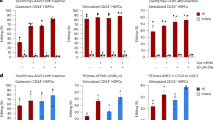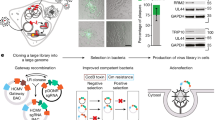Abstract
Friend erythroleukemia induced in mice by the spleen focus forming virus (SFFV) is a multi-step process. The pre-leukemic phase of the disease results from the abnormal activation of the Erythropoietin (Epo) receptor by the gp55 env gene product of SFFV. Later in disease progression, the emergence of leukemic clones is associated with recurrent genetic events, in particular the activation of the expression of SPI-1, an ETS family transcriptional regulator. We show here that the expression of either SPI-1 or GP55 with the mouse EPOR in avian primary erythroblasts only marginally affects their normal Epo-induced terminal differentiation. In contrast, the co-expression of GP55 and SPI-1 resulted in inhibition of Epo-induced differentiation of EPOR-expressing erythroblasts, promoting instead their proliferation. Co-expression of SPI-1 and GP55 also inhibited the apoptotic cell death program normally induced in response to Epo withdrawal. This cooperation between SPI-1 and GP55 to induce primary erythroblast transformation suggests that progression of Friend erythroleukemia critically depends upon inter-dependent interactions between the molecular events specific of the early and late phase of the disease.
This is a preview of subscription content, access via your institution
Access options
Subscribe to this journal
Receive 50 print issues and online access
$259.00 per year
only $5.18 per issue
Buy this article
- Purchase on Springer Link
- Instant access to full article PDF
Prices may be subject to local taxes which are calculated during checkout



Similar content being viewed by others
References
Behre G, Whitmarsh AJ, Coghlan MP, Hoang T, Carpenter CL, Zhang DE, Davis RJ and Tenen DG. . 1999 J. Biol. Chem. 274: 4939–4946.
Ben-David Y and Bernstein A. . 1991 Cell 66: 831–834.
Constantinescu SN, Wu H, Liu X, Beyer W, Fallon A and Lodish HF. . 1998 Blood 91: 1163–1172.
DeKoter RP and Singh H. . 2000 Science 288: 1439–1441.
Hankins W. . 1980 Cell 22: 693–699.
Klingmuller U. . 1997 Eur. J. Biochem. 249: 637–647.
Knight J, Zenke M, Disela C, Kowenz E, Vogt P, Engel JD, Hayman MJ and Beug H. . 1988 Genes Dev. 2: 247–258.
Lin CS, Lim SK, D'Agati V and Costantini F. . 1966 Genes Dev. 10: 154–164.
Longmore GD, Pharr PN and Lodish HF. . 1994 Mol. Cell. Biol. 14: 2266–2277.
Moreau-Gachelin F, Tavitian A and Tambourin P. . 1988 Nature 331: 277–280.
Moreau-Gachelin F, Wendling F, Molina T, Denis N, Titeux M, Grimber G, Briand P, Vainchenker W and Tavitian A. . 1996 Mol. Cell. Biol. 16: 2453–2463.
Muszynski KW, Ohashi T, Hanson C and Ruscetti SK. . 1998 J. Virol. 72: 919–925.
Pereira R, Tran Quang C, Lesault I, Dolznig H, Beug H and Ghysdael J. . 1999 Oncogene 18: 1597–1609.
Persons DA, Paulson RF, Loyd MR, Herley MT, Bodner SM, Bernstein A, Correll PH and Ney PA. . 1999 Nature Genet. 23: 159–165.
Pongubala JM, Van Beveren C, Nagulapalli S, Klemsz MJ, McKercher SR, Maki RA and Atchison ML. . 1993 Science 259: 1622–1625.
Rao G, Rekhtman N, Cheng G, Krasikov T and Skoultchi AI. . 1997 Oncogene 14: 123–131.
Ruscetti SK, Janesch NJ, Chakraborti A, Sawyer ST and Hankins WD. . 1990 J. Virol. 64: 1057–1062.
Steinlein P, Deiner E, Leutz A and Beug H. . 1994 Growth Factors 10: 1–16.
Tamir A, Howard J, Higgins RR, Li YJ, Berger L, Zacksenhaus E, Reis M and Ben-David Y. . 1999 Mol. Cell. Biol. 19: 4452–4464.
Tran Quang C, Wessely O, Pironin M, Beug H and Ghysdael J. . 1997 EMBO J. 16: 5639–5653.
Witthuhn BA, Quelle FW, Silvennoinen O, Yi T, Tang B, Miura O and Ihle JN. . 1993 Cell 74: 227–236.
Wolff L and Ruscetti S. . 1985 Science 228: 1549–1552.
Wu H, Liu X, Jaenisch R and Lodish HF. . 1995 Cell 83: 59–67.
Acknowledgements
We thank Maryvonne Williame for expert technical assistance. R Pereira is supported by a pre-doctoral fellowship from the Ligue Nationale Contre le Cancer. This work is supported by funds from Centre National de la Recherche Scientifique, Institut Curie, Association for International Cancer Research (AICR) and Association contre le Cancer (ARC).
Author information
Authors and Affiliations
Rights and permissions
About this article
Cite this article
Pereira, R., Raingeaud, J., Pironin, M. et al. SPI-1 transforming properties depend upon specifically activated forms of the EPOR. Oncogene 19, 5106–5110 (2000). https://doi.org/10.1038/sj.onc.1203886
Received:
Revised:
Accepted:
Published:
Issue Date:
DOI: https://doi.org/10.1038/sj.onc.1203886



